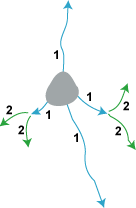Tree totals (branched structure)

Tree totals combines the totals based solely on the centrifugal branch ordering method. To select additional branch ordering methods, use the Options>General Preferences>Orderings tab. About branch orders
Analysis results
Reports the centrifugal branch ordering.
Branch orders from additional methods appear below the results for the centrifugal order if you selected additional branch orders.
Number of trees for a given branch order.
Total length for all branches in the tree with the same branch order.
- Mean = [Length total] / [Quantity]
- Variance: set to 0 if there is only 1 branch; otherwise, computed for the set of branches.
Computed by modeling each piece of each branch as a frustum (truncated right circular cone).
- Mean = [Surface or Volume total] / [Quantity]
- Variance: set to 0 if there is only 1 branch; otherwise, computed for the set of branches.
Number of segments of that branch order ending in nodes.
Degrees (0, 1, 2, >2):
- Termination: degree 0.
- Bifurcation: degree 2.
- Nodes of degree higher than 2 are grouped under >2.
The numbers of endings are counted according to their type (i.e., normal, high, low, incomplete, origin, midpoint, and generated).
The types were selected while tracing in Neurolucida.
| Normal Ending (N) | Default |
| High Ending (H) | Ending located at the top of the current section. Depending on the orientation of the sections, the process may continue into another section.
|
| Low Ending (L) | Ending located at the bottom of the current section. |
| Incomplete (I) | Use to label arbitrary endings, endings that disappear for unknown reasons, endings that should be audited later.. |
| Origin Ending (O) | Indicates the directionality of the tree.
|
| Midpoint (M) | An ending of a long branch that is indeterminate at the time it is placed. |
